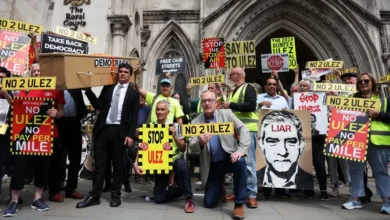Fighting Russia from a distance: Inside a Ukrainian drone school

Andrey Pronin doesn’t know how many drones he has crashed.
“I lost count after 100,” the 44-year-old, camouflage-clad instructor told Al Jazeera while observing three cadets of his drone flight school pilot their buzzing aircraft over a withering meadow just outside Kyiv.
Survival!’
Viktoria was sitting next to six men in a dark classroom on the top floor of a drab office building in southeastern Kyiv, listening to theoretical portions of the course. Pronin was projecting slides onto the wall to explain things like frequencies used for flying the drone and getting video feedback.
Four of the men were active servicemen dispatched by their military units to master a new skill. Taciturn and focused, they refused to be interviewed or photographed – and only one of them blurted out “survival!” when asked about his motivation.
That’s the keyword for any aspiring drone pilot or engineer, especially during Ukraine’s conscription crisis when thousands of men of fighting age are forcibly rounded up and sent to boot camps – or bribe their way out.
“Let’s be realistic. If you are taken by conscription officers, you pay 8,000 hryvnias [a little less than $200], and they let you go,” Pronin said. “That’s the price of our training course.”
Moreover, the 16-day, Ministry of Defence-certified training course offered by Pronin and his partner Roman, who withheld his last name for security reasons, is a pathway to join what in many ways is the newest military elite.
Bang for Ukraine’s buck
Washington’s wars in Afghanistan and Iraq and the war between Azerbaijan and Armenia over the Nagorno-Karabakh region showed how important heavy drones such as Predators and Bayraktars have become on the battlefield. But the Russia-Ukraine war has become the world’s first military conflict to be dominated by lightweight first-person-view (FPV) drones.
Pronin’s cadets bring plastic water bottles bought and weighed at supermarkets on their way to their drills, so they can practise flying with the extra weight. Those plastic bottles can be replaced with an explosive flown into a Russian trench or a tank with an open hatch with a shocking price-to-quality ratio.
FPV drones that cost less than $1,000 have destroyed two-thirds of Russian tanks that cost millions, a NATO official said in April.
Most FPV drones are propeller-driven and helicopter-like and can carry anything from heat detectors and night-vision cameras to food, water and medical supplies.
Larger, more advanced ones can perform comparable tasks to Predator or Bayraktar drones.
One is Vampire, a Ukrainian-made heavy drone equipped with a machinegun that hunts down Russian servicemen at night. Russians call it “Baba Yaga” after a children-eating witch from Slavic folklore.










